Chemicals Used in Paints A Comprehensive Overview
The world of paint is not just a colorful realm of aesthetics; it is also a complex amalgamation of various chemicals that work together to provide the desired finish, durability, and safety. Understanding the key chemicals used in paints is essential for consumers, manufacturers, and environmentalists alike, given the potential health risks and environmental impacts associated with certain substances.
At its core, paint is composed of four primary components pigments, binders, solvents, and additives. Each of these plays a critical role in the performance and quality of the final product.
1. Pigments The Color Providers
Pigments are finely ground particles that provide color and opacity to paints. They can be classified into two categories organic and inorganic. Organic pigments, often used for bright and vivid colors, are derived from carbon compounds and are generally more expensive. In contrast, inorganic pigments, which are usually metal oxides or sulfides, offer greater stability and are often used for more muted tones or earth colors.
Common inorganic pigments include titanium dioxide (for white), iron oxides (for reds and browns), and ultramarine blue. However, the use of certain pigments has become scrutinized due to potential health risks. For example, lead-based pigments, banned in many countries, were once popular for their durability and vibrant colors but posed severe toxicity risks.
2. Binders The Adhesive Agents
Binders, also known as resins, hold the pigments together and ensure adhesion to the surface being painted. They form a film as the solvent evaporates, and this film provides the paint's durability and longevity. There are two main types of binders natural and synthetic.
Natural binders, like linseed oil, have been used for centuries but may not offer the same level of performance as synthetic counterparts. Synthetic resins such as acrylic, alkyd, and polyurethane are now common and are favored for their quick drying times and resistance to fading, weathering, and other environmental factors.
3. Solvents The Thinning Agents
chemicals used in paints

Solvents are crucial for controlling the viscosity of paint, making it easier to apply. Historically, paints contained solvents derived from petroleum products, such as toluene and xylene, which can release volatile organic compounds (VOCs) into the atmosphere. These VOCs can contribute to air pollution and pose health risks, including respiratory issues and dizziness.
In response to growing environmental concerns, many manufacturers now produce low-VOC or zero-VOC paints, which utilize water or less harmful solvents as the primary thinning agents. Water-based paints have gained popularity for their effectiveness and reduced impact on indoor air quality.
4. Additives The Performance Enhancers
Additives are used in small amounts to enhance specific properties of the paint. These can include agents that improve drying time, enhance mold resistance, prevent foaming, and increase shelf life. Some common additives include biocides, defoamers, and surfactants.
However, the use of additives also requires careful consideration. For example, certain biocides may be effective in preventing mold growth but can also be toxic to aquatic life once washed off surfaces.
Environmental and Health Considerations
The chemical composition of paints has implications not only for the quality of the painted product but also for health and environmental sustainability. As consumers become more aware of potential hazards, there is a growing demand for paints made with safer, more environmentally friendly ingredients.
Regulatory measures have been put in place around the world to limit the use of harmful chemicals in paints. Organizations like the Environmental Protection Agency (EPA) in the United States assess the risks associated with various paint ingredients and establish guidelines to protect public health.
Conclusion
In conclusion, while paints can brighten our environments and enhance aesthetics, they are also a blend of chemicals that require careful consideration. By understanding the various components, including pigments, binders, solvents, and additives, stakeholders can make informed choices, leading to safer applications and reduced environmental impact. The future of paint lies in the balance between performance, safety, and sustainability, pushing the industry towards innovative solutions that cater to both consumer preferences and ecological concerns.
-
Rdp that The Revolutionary Polymer Powder Transforming Modern Construction MaterialsNewsAug.11,2025
-
Hpmc Powder that Versatile Additive for Detergents and Personal CareNewsAug.11,2025
-
Hpmc Hydroxypropyl Methylcellulose that Essential Building Material Additive from Shijiazhuang Gaocheng YongfengNewsAug.11,2025
-
Hydroxypropyl Methyl Cellulos Hpmc that Essential for Construction ApplicationsNewsAug.11,2025
-
Mhec Powder that Revolutionizing Construction Chemistry with Cellulose Ether SolutionsNewsAug.11,2025
-
Industri Hpmc that The Global Backbone of Advanced ConstructionNewsAug.11,2025




